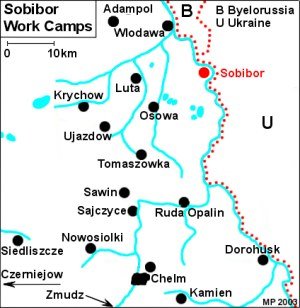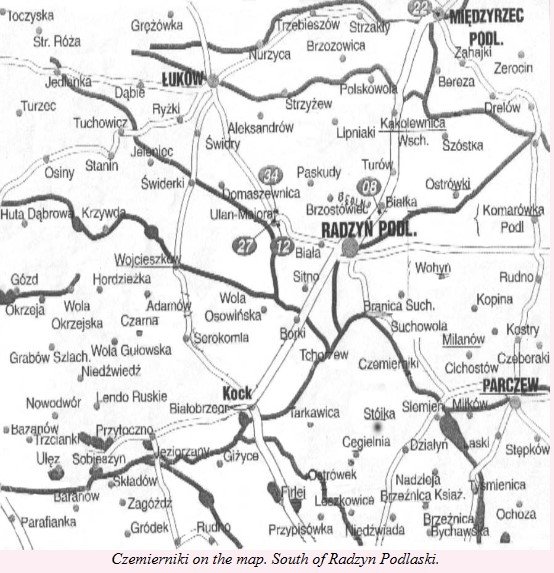Remember Jewish Czemierniki
Pronunciation: Tch-em-eer-nicki or Tsh-mernick
HISTORY OF JEWISH CZEMIERNIKI
Czemierniki is a village in east-central Poland, with a population of around 1,700. It was also spelled Chemenik, Chemernik, and Chemyernik. The village is 8 miles south of Radzyn Podlaski, 30 miles north of Lublin, and 44 km southeast of Lukow.
In 1703, Jakub Sobieski allowed Jews to settle in Czemierniki. They established a separate cemetery, called "Okopiskiem". In 2000, a monument commemorating the site of the former Jewish cemetery was placed. It is located near the warblers 'Birchwood' to the right of the main road Czemierniki — Radzyn Podlaski. The first synagogue was built in 1730. That building may have been erected on the site of a former synagogue. In the mid-1800s, a kehilla was established in the village. Around 1880, there were 559 Jews in Czemierniki. That number reached 1,000 by 1900, around 40% of the total village population.
The year 1703 brought a wave of Swedish troops ravaging the village. It was nearly destroyed then, and again in 1711 when a fire broke out. In 1813 another fire consumed the village. In 1855 and 1873, a cholera epidemic struck the village. In 1869, as part of the post-January Uprising repercussions, Czemierniki lost its status as a village and the privileges that go along with that. In 1880, the village had the following amenities: a steam sawmill, a watermill, a brewery, two oil mills, a brickyard, soap works, the municipal office, an elementary school and a loan fund.
By 1921, the Jewish population numbered 1,004 and represented 42% of the town's population. A synagogue, a Jewish cemetery and a mikveh was under kehilla's supervision prior to WWII. The synagogue was destroyed in the Holocaust. The cemetery was also destroyed. No graves remain. The cemetery was located at Polnoc street. It was erected in the 19th Century. In 1930, the city employed the following Jews: Rabbi Froim Feldman; shochets Dawid Gotes and Mendel Wajs; secretary Jacob Tauberg; collector Szaja Wierniki; synagogue sexton Moshe Kamionka; mikvah supervisor Moshe Melczak; and Mordko Lichtenberg, whose position was unclear.
CZEMIERNIKI DURING THE SHOAH
Many Jews escaped from Czemierniki and headed for the USSR in 1939; the village was left with about 700 Jewish inhabitants. In the spring of 1940, a ghetto was formed by the Nazis. Apart from Czemierniki's population, a group of refugees from other centers -- 1,000 people in all -- were placed in the ghetto. In 1942, the Nazis shot 36 Jews accused of helping the partisans. At the turn of October and November of 1942, Jews were deported from Czemierniki to the ghetto in Parczew — from where they were sent to the Treblinka Death Camp. In the spring of 1945, the Home Army (Armia Krajowa) murdered several other Czemierniki Jewish Holocaust survivors.
Please review the site content below. Zachor - We Remember.
------------------------------------------------------------------------
[History] [Demographics] [Jewish Life] [Wikipedia - Czemierniki]
[Persecuted persons, Parczew] [Synagogue] [Cemetery]
[Jewish Partisans in the Parczew Forest]
------------------------------------------------------------------------
1929 Polish Business Directory Listing — Czemierniki, Poland
Koladzieje (wheelwright): Branicki
Kolowrotki: M. Linski
Kowale (blacksmith): S. Krol
Spozywczo artykuly (grocery store): M. Kazubek
Stolarze (carpenter): W. Kozak
Tartaki: Sz. Rozner, I. Rozenberg
Wiatraki (windmill): F. Kwas, T. Wysocki
LINKS
Join the Czemierniki group on Facebook!
Czemierniki:
Ostrow Lubelski Jewish Descendants on Facebook
Ostrow Lubelski Yizkor Book
Parczew Ghetto
Parczew Jewish Descendants on Facebook
Radzyn Podlaski Yizkor Book
Families of Czemierniki:
Fefferkorn/Feferkorn family
Grycmacher family
Majdan Tatarski Ghetto Victims (Lublin) from Czemierniki:
Mates Fajsfisz
Mala Froman
Dwojra Monk
(source: Brama Grodzka - Teatr NN)
Notable People:
Szloma Himmelblau
Szlomo Lichtenberg
Survivors of Czemierniki:
Blima Akierman (went to Sweden)
Hannah F.
Moszek Fajerstajn
Yechiel Grynszpan (went to Brazil)
Froim Langman (went to Sweden)
Joseph Mandrowitz
Rabbis of Czemierniki:
Chil Gertner, 1848-1852
Aron Himmelblau
Righteous Gentiles:
Jan Poddebniak
Genealogy:
Jewish Records Indexing Poland - Czemierniki
Jewish Vital Records in the Polish State Archives
Remember Your Family:
Central Judaica Database - Museum of History of Polish Jews
Grandchildren of Holocaust Survivors on Facebook
Guide to the YIVO Archives
Holocaust News/Events from Generations of the Shoah Int'l
Holocaust Survivors and Victims Database
JewishGen Family Finder
JewishGen Holocaust Database
JRI-Poland: Search for Your Family
Museum of History of Polish Jews Introduction
Yad Vashem: Search for Your Family
Yad Vashem: Submit Names of Your Family Members
Yad Vashem Requests Photos of Shoah Survivors and Families
CONTACTS
U.S.: LublinJewish@gmail.com
Memorial to murdered Jews in Smuga Forests near Parczew, unveiled by the Lasting Memory Foundation in November 2013. Memorial includes the following victims’ names: Usher Pertman, Gitla Pertman, Judka Pertman, Dawid Pertman, Chaim Pertman, Yolko Pertman, Szyja Szerman, Fajga Szerman, Sheva Szerman, Ita Szerman, Tova Fiszman, Moszek Fiszman, Szyja Fiszman, Fajga Fiszman, Gitla Walner, Herszek Walner, and five victims whose surnames are not known. Zachor — we remember them. Learn more about The Lasting Memory Foundation.





